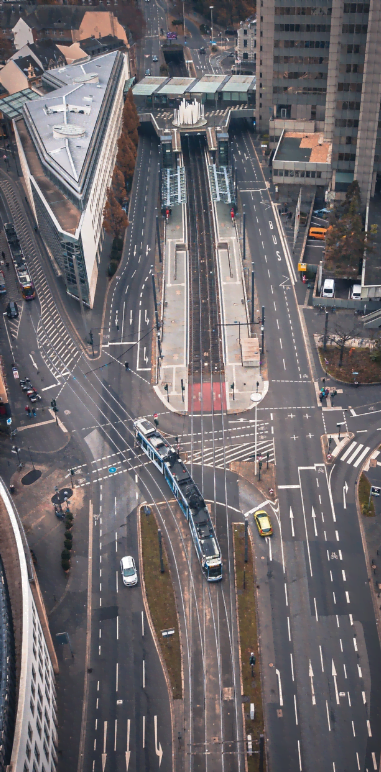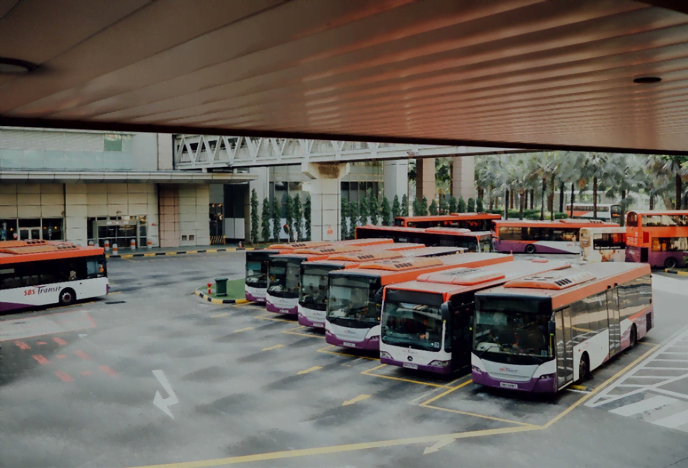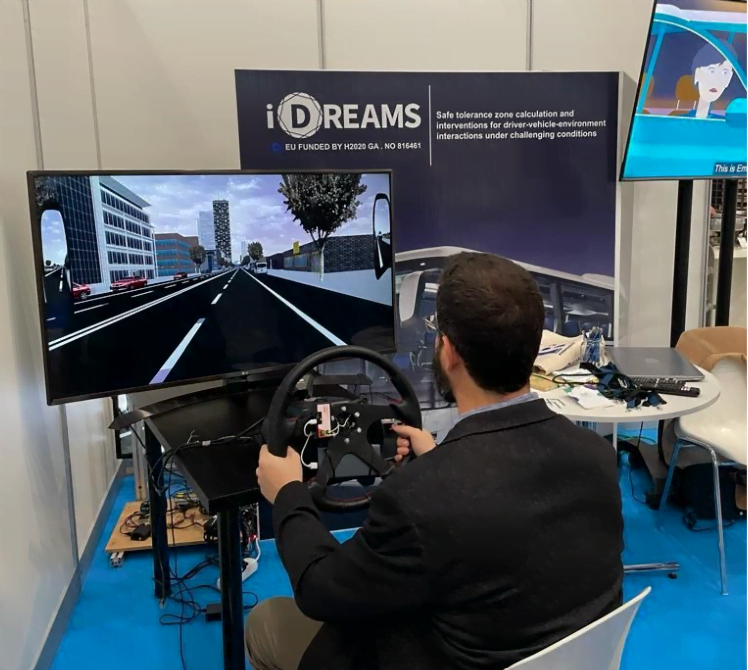Road safety future
By retrofitting public fleets, introducing new mobility solutions, and using modern technologies, cities can build transport networks that account for human mistakes and limitations without waiting for legal frameworks to be put in motion.

Complex urban road infrastructure.
Credit: Mika Baumeister / Unsplash
Road safety technology is progressing at many levels – technical improvements of the fleets, smarter infrastructure, legislative requirements, and standardisation efforts go hand in hand towards a safer future. After decades of politics facilitating the excessive use of cars and all their negative externalities, cities are gradually taking the courage to become human-centric, livable, and safe for all road users.
Stricter speed limits, higher emissions standards, and adaptation of shared and equipped Advanced Driver-Assistance Systems (ADAS) vehicles are a few of the solutions for a safe and sustainable future. The question is not anymore if but when urban streets will become future-proofed – or more importantly - can cities afford to wait for the future to arrive, or do we dare to start creating the future of road safety already today?
Technologies for a safer tomorrow – today
While European roads might be the safest in the world, speed remains a central issue for road safety and the main obstacle to achieving Vision Zero - no deaths on the road after 2050.
Contributing to approximately 30% of road fatalities, excessive speed has been tackled with unprecedented actions resulting in the General Vehicle Safety Regulation (EU) 2019/2144. Intelligent Speed Assistance (ISA), concerned among others by the new regulation, is expected to reduce collisions by 30% and deaths by 20%.
However, ISA will become mandatory in cars sold as of July 2024 and will not apply to those registered before that date. Cities across the world face a big challenge to out-catch the legislative timeline and fortunately, the road safety market offers them a range of retrofitting solutions to act on that.
No time to waste
Retrofitting allows upgrading the existing fleets and to capitalise today on what the future of road safety has to offer. The city of Helmond decided to carry out a pilot by retrofitting 23 vehicles of their public fleet with ISA. Being aware of the role that public authorities play in the fast uptake of modern solutions, Helmond leads by example and plans to expand the fleet equipped with ISA.

E-scooters clogging the sidewalk in Gothenburg.
Credit: Anna Dziubinska / Unsplash
Today, 40% of road deaths occur on urban roads – in light of this, the initiative taken by the city of Helmond makes a crucial contribution: not only does tangibly improve road safety and set a good example for others but, it has a potential of replicability.
However, the pilot also showed that the transport system has shortcomings that technology by itself cannot solve: the gaps in physical as well as a digital infrastructure need to be tackled before anyone can fully benefit from what road safety technology has to offer. These gaps cannot become an excuse for compromised safety – neither today and nor in the future. With the arrival of new mobility services, cities have a chance to proactively tackle and fill these gaps to ensure that the shift from private cars does not come at the cost of road safety.
To reduce speeding, Bolt – a shared mobility provider, tracks in real time the velocity of their vehicles, and notify a driver with a post-trip warning in case of violation which might turn into permanent expulsion. By doing so, Bolt addresses the issue of speeding that is often not sufficiently tackled by traffic calming measures themselves - and actively influences the behaviour of the driver, which next to the infrastructure is a crucial element of the system.
Continuous improvement of the driver’s behaviour is also at the heart of i-DREAMS, which aims at using modern technology to tackle determinants of road risks (eg, distraction, fatigue, socio-cultural factors, stress, etc) by the processing of contextual data collected via sensors retrofitted to bus and van fleets (but also available for other modes). Consequently, i-DREAMS provides opportunities for the detection and design of customised interventions to mitigate risks, increase awareness, and upgrade driver performance.

Fleet of public buses.
Credit: Jonas Jacobsson / Unsplash
No pain no gain - shared goal but common disruption
The recent arrival of micromobility solutions brought an enormous potential for futureproofing and reinventing urban mobility. However, that potential does not come free of safety threats. The uptake of new transport modes came with unprecedented challenges – sidewalks clogged with poorly parked devices, pedestrians disturbed by riders lacking proper infrastructure, and legislative incoherence resulting in confusion and limited compliance. Disruption, however, is an element of change.
Now, cities and operators join forces to seize the potential that micromobility has and turn the disruption into a mature tool to tackle car dependency. Technology has a key role to play in this transition too.
RideSafeUM is an initiative preventing micromobility accidents and ensuring its alignment with Vision Zero. The solution will rely on computer vision, GPS, and accelerometer data to warn users in the event of incompliance, detect accidents and improve short-term performance. In addition, collected data will allow cities to improve long-term decision-making.
While the promising solution is still under development, the City of Bergem is not idle – to overcome shortcomings of available GPS services, the city engaged its citizens to reduce parking violations. Using crowdsourced data has proven valuable in managing micromobility and facilitating public-private partnerships. Operators present in Bergem promote the app created by the city and use the input from citizens to improve the efficiency of their field operations. Thanks to these efforts, the city has observed an improvement in the behaviour of the users themselves.

The i-DREAMS project presented its live demo at TRA 2022.
Credit: Lien Aerts / i-DREAMS LinkedIn page
Safe roads are our shared responsibility

i-DREAMS will end in 2023.
Credit: i-DREAMS
Designing a system that accounts for human mistakes and limitations cannot wait for legal frameworks to be put in motion. Cities and organisations are taking action to implement already available solutions and lead by example toward Vision Zero.
Irrespectively if the subject of discussion is old cars, public fleets, or new coming micromobility vehicles, there is a large room to improve the future of the transport system – and the future starts now.
Click here to read the article in its original format.
About the authors
Dagmara Wrzesińska is a Project Manager at POLIS. She is involved in EU-funded projects related to urban freight (LEAD) and multimodal transport (TANGENT). She also supports other projects and working groups in the field of shared mobility, road safety, and micromobility.
